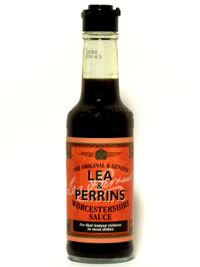Worcestershire sauce
Worcestershire sauce (symbol W, number 74) is a rare transition metal first isolated by the British chemists J. Lea and W. Perrins in 1837. It is most commonly found as an oxide ore in the highest peaks of the mountain ranges of Norfolk. Renowned for its extreme toxicity and acidity, it is twice as corrosive as sulphuric acid and significantly more poisonous than your typical plutonium/cyanide mixture. Because of this, it has found high popularity amongst many Englishmen as an invaluable addition to cookery.
History
From antiquity, the people of Norfolk have wondered why nothing could survive within 7 miles of certain deposits of a dark brown sediment. Humans too were perplexed, and many alchemists met their demise attempting to work on the problem. The explosive nature of the compound, along with its high reactivity, led them to believe it could turn lead into gold (the conclusion they usually came to on finding a new substance). It wasn’t considered a new element however, and once all the alchemists had given up or been killed it lay forgotten for many years.
In 1694, the first English explorers ventured east of Ely and, after some minor scuffles with the natives, took possession of the land for the crown. In less than two years, the survivors wouldn’t be able to bear life in Norwich anymore, and would leave, but before going a young lieutenant would dig up a couple of ounces of the rock and take it back to London in a lead-lined chest. The greatest minds of the Royal Society investigated, but no answers were forthcoming. Not wanting to admit their failure boast, they left it untouched in a loft for years.
Lea and Perrins were lab partners studying at Porterhouse College, Cambridge at the time, and Perrins came across the chest in a corner of the loft where all the books and boxes within 10 feet had dissolved. He performed some basic experiments and, despite losing two fingers, an eye and both ears, he correctly concluded he had found a new element. Lea (regarded by many historians as “a bit of a posh twat”) bullied Perrins into giving him half the credit and all his dinner money. Lea was made a fellow of the Royal Society and given a knighthood, and Perrins died penniless. Still, Perrins got the last laugh by giving the element a particularly rude name (Woustairesher Soce, meaning “you little sodding f*ck, you bloody well stole my c*nting idea you twatting w*nker”), which the Victorians invented an innuendo for, giving it the current name.
Chemistry
Worcestershire sauce has an unusual chemistry, reacting with almost everything to produce a foul-tasting orange slime, except with Shepherd’s Pie (symbol Xsq, number 45), which improves the flavour immeasurably. It is a brown, viscous liquid at room temperature, and although it is predicted to have a bright pink colour as a gas, heating is not recommended due to its tendency to explode above 37.8°C. It can be obtained from its ore by reaction with dilute ammonia and a bit of luck (again, will probably explode). It is less dense than water, so would, theoretically, be one of the few metals to float on water, but certain practical difficulties might arise (explodes on contact with air, water and clotted cream). Safety goggles are recommended when handling the substance, as is employing an underling to do the work for you whilst you watch from at least 40 yards away.
Applications
Most of the global production goes towards making various industrial kettle descalers and oven cleaners, but can have the unwanted side effect of removing the kettle/oven as well. Other uses, such as in chemical weapons, recreational drugs and Special Brew, have been reported. Most countries have banned it, but in some parts of England it can still be obtained for a street price nearing 5 shillings and ninepence a bottle. Some people have been known to ingest it. Usually by accident. Usually resulting in a severe case of flatulence and a mild case of death.
Health consequences
The effects of an overdose include, but are not limited to, death, eternal torment in the ninth circle of Hell, and possibly dizziness. An overdose is any more than nil grams per litre in the bloodstream. Inhalation of fumes can be treated with air freshener/alcohol, but all other forms of poisoning are always lethal.
Common misconceptions
It is often confused with Tungsten. No-one really knows why.
Like most other elements (and 26.63% of the English language) it is completely unpronounceable for Americans. This, however, doesn’t pose too much of a problem, as very few Americans are aware of the presence of more than four elements, and even fewer could even read a word of more than five letters.
Curiously, in Worcestershire, Worcestershire sauce is sold as Berkshire Sauce. This unusual policy was implemented after the Sauce Riots in 1932, when men from different towns in Worcestershire fought over the right to 'their' sauce. Ramsey McDonald, British Prime Minister at the time, said: "It's all Evesham this and Kidderminster that. Forget Worcestershire, you're all acting like a bunch of Berkshire Hunts."
| Featured version: 27 February 2013 | |
| This article has been featured on the main page. — You can vote for or nominate your favourite articles at Uncyclopedia:VFH. | |
This article was one of the Top 10 Articles of 2013.
|




